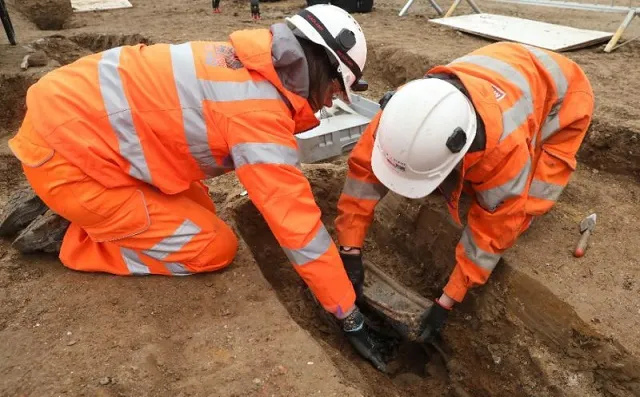Các nhà khảo cổ hôm 25/1 cho biết họ đã phát hiện ra một quan tài nhận định là của thuyền trưởng Hải quân Hoàng gia Matthew Flinders sau khi đào bới một khu vực an táng rộng gần nhà ga Euston.

Các nhà khảo cổ đã tìm được hài cốt nhà thám hiểm tìm ra vùng đất Australia. Ảnh: AFP
Flinders được chôn cất vào ngày 23 tháng 7 năm 1814, sau khi cho xuất bản cuốn “Cuộc hành trình đến vùng đất phương Nam” (“A Voyage to Terra Australis”), trong đó mô tả chuyến hải trình vòng quanh nước Úc vào năm 1802-1803 và xác định đây là một châu lục.
Với gần 40.000 hài cốt trong khu vực, các nhà khảo cổ không chắc chắn về vị trí họ cần tìm nhưng họ đã thật sự may mắn. Hài cốt mà họ tìm thấy xác định là của nhà thám hiểm Flinders có miếng mề đay đeo trước ngực bằng chì nên đã không bị thiêu hủy.
Helen Wass, một nhà khảo cổ trong nhóm bình luận giờ đây họ đã có thể thực hiện nghiên cứu việc thám hiểm trên biển dài ngày có để lại dấu ấn nào trên cơ thể ông và từ đó có thể hiểu nhiều hơn về Flinders.
Flinders là người hùng của nhiều người Úc gốc Châu Âu, khi có nhiều nhà ga, con đường, con phố và thị trấn trên khắp đất nước đặt theo tên ông.
Việc phát hiện ra di hài của ông đã hoàn thành trước Ngày Quốc khánh Úc “Australia Day”, một ngày lễ quốc gia đang gây tranh cãi khi xác định bằng ngày mà tàu Hạm đội đầu tiên của Anh đặt chân đến vùng đất Úc.
Nhiều người Úc lại cho rằng Hạm đội đầu tiên và những người như Flinders là nguyên nhân gây ra sự tàn lụi của xã hội và văn hóa thổ dân cổ đại. Ngoài ra, cũng có ý kiến tranh cãi về vai trò của một phụ tá tên Bungaree của Flinders, người mà hiện nay đã được ghi nhận có nhiều công lao đối với sự thành công của chuyến thám hiểm tìm ra châu Úc.
Remains found of explorer who put Australia on the map
(AFP) - The remains of the first British explorer to circumnavigate the Australian continent and popularise the country's name have been found near a busy London railway station.
Archaeologists sifting through a vast burial ground near Euston station said Friday they had found a coffin plate identifying the last resting place of Royal Navy captain Matthew Flinders.
Flinders was buried on 23rd July 1814, but not before publishing "A Voyage to Terra Australis," which described his circumnavigation of Australia in 1802-1803 that proved it was a continent.
"Flinders put Australia on the map due to his tenacity and expertise as a navigator and explorer," said Helen Wass, an archaeologist overseeing the dig for the HS2 high speed rail project.
With an estimated 40,000 remains at the site, archaeologists were not sure they were going to find Flinders, whose resting place had been subject to much speculation.
"We were very lucky" said Wass, he "had a breastplate made of lead meaning it would not have corroded."
"We'll now be able to study his skeleton to see whether life at sea left its mark and what more we can learn about him."
Flinders is a hero for many Australians of European origin, with stations, streets, squares and towns across the country named after him.
The discovery of his remains comes on the eve of "Australia Day" a controversial national holiday which falls on the date of the arrival of the British First Fleet to Australia.
Many Australians view the Fleet and men like Flinders as harbingers of the decimation of ancient Aboriginal societies and cultures.
There is added controversy over the role of an aboriginal Australian aide to Flinders named Bungaree, who has been largely eclipsed by his British captain, but who historians now believe played a crucial role in success of the voyages.


